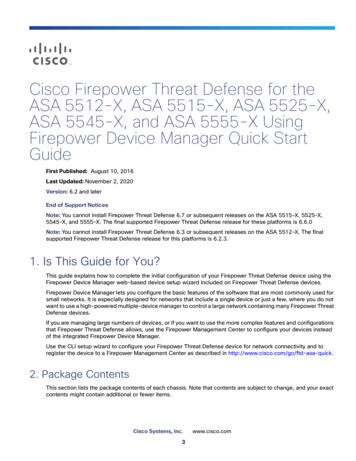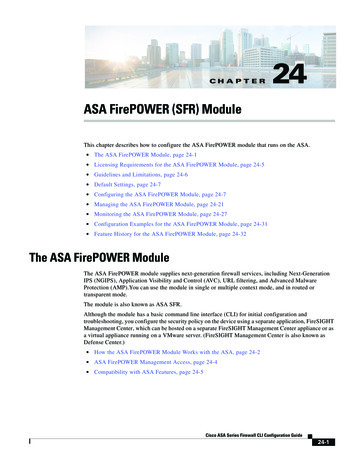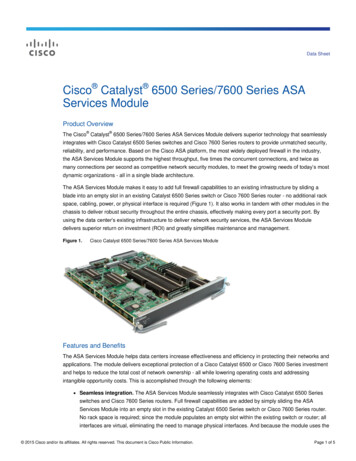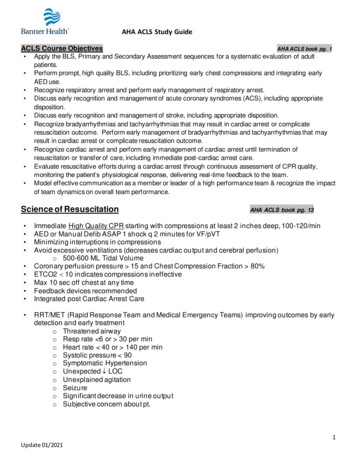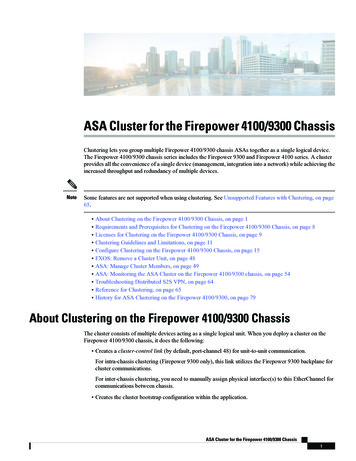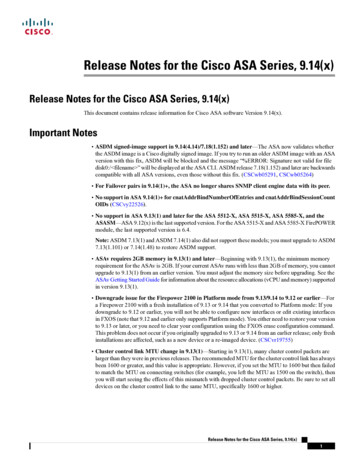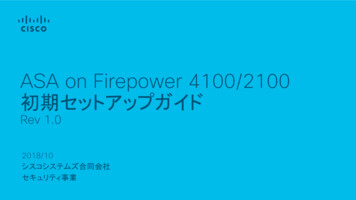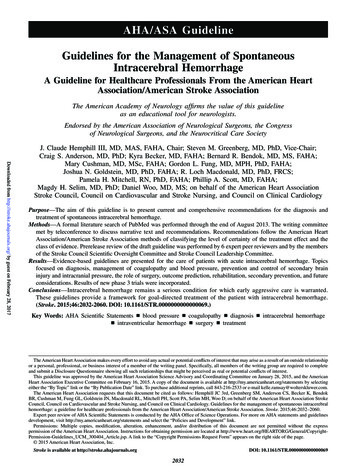
Transcription
AHA/ASA GuidelineGuidelines for the Management of SpontaneousIntracerebral HemorrhageA Guideline for Healthcare Professionals From the American HeartAssociation/American Stroke AssociationThe American Academy of Neurology affirms the value of this guidelineas an educational tool for neurologists.Endorsed by the American Association of Neurological Surgeons, the Congressof Neurological Surgeons, and the Neurocritical Care SocietyDownloaded from http://stroke.ahajournals.org/ by guest on February 28, 2017J. Claude Hemphill III, MD, MAS, FAHA, Chair; Steven M. Greenberg, MD, PhD, Vice-Chair;Craig S. Anderson, MD, PhD; Kyra Becker, MD, FAHA; Bernard R. Bendok, MD, MS, FAHA;Mary Cushman, MD, MSc, FAHA; Gordon L. Fung, MD, MPH, PhD, FAHA;Joshua N. Goldstein, MD, PhD, FAHA; R. Loch Macdonald, MD, PhD, FRCS;Pamela H. Mitchell, RN, PhD, FAHA; Phillip A. Scott, MD, FAHA;Magdy H. Selim, MD, PhD; Daniel Woo, MD, MS; on behalf of the American Heart AssociationStroke Council, Council on Cardiovascular and Stroke Nursing, and Council on Clinical CardiologyPurpose—The aim of this guideline is to present current and comprehensive recommendations for the diagnosis andtreatment of spontaneous intracerebral hemorrhage.Methods—A formal literature search of PubMed was performed through the end of August 2013. The writing committeemet by teleconference to discuss narrative text and recommendations. Recommendations follow the American HeartAssociation/American Stroke Association methods of classifying the level of certainty of the treatment effect and theclass of evidence. Prerelease review of the draft guideline was performed by 6 expert peer reviewers and by the membersof the Stroke Council Scientific Oversight Committee and Stroke Council Leadership Committee.Results—Evidence-based guidelines are presented for the care of patients with acute intracerebral hemorrhage. Topicsfocused on diagnosis, management of coagulopathy and blood pressure, prevention and control of secondary braininjury and intracranial pressure, the role of surgery, outcome prediction, rehabilitation, secondary prevention, and futureconsiderations. Results of new phase 3 trials were incorporated.Conclusions—Intracerebral hemorrhage remains a serious condition for which early aggressive care is warranted.These guidelines provide a framework for goal-directed treatment of the patient with intracerebral hemorrhage.(Stroke. 2015;46:2032-2060. DOI: 10.1161/STR.0000000000000069.)Key Words: AHA Scientific Statements blood pressure coagulopathy diagnosis intracerebral hemorrhage intraventricular hemorrhage surgery treatmentThe American Heart Association makes every effort to avoid any actual or potential conflicts of interest that may arise as a result of an outside relationshipor a personal, professional, or business interest of a member of the writing panel. Specifically, all members of the writing group are required to completeand submit a Disclosure Questionnaire showing all such relationships that might be perceived as real or potential conflicts of interest.This guideline was approved by the American Heart Association Science Advisory and Coordinating Committee on January 28, 2015, and the AmericanHeart Association Executive Committee on February 16, 2015. A copy of the document is available at http://my.americanheart.org/statements by selectingeither the “By Topic” link or the “By Publication Date” link. To purchase additional reprints, call 843-216-2533 or e-mail kelle.ramsay@wolterskluwer.com.The American Heart Association requests that this document be cited as follows: Hemphill JC 3rd, Greenberg SM, Anderson CS, Becker K, BendokBR, Cushman M, Fung GL, Goldstein JN, Macdonald RL, Mitchell PH, Scott PA, Selim MH, Woo D; on behalf of the American Heart Association StrokeCouncil, Council on Cardiovascular and Stroke Nursing, and Council on Clinical Cardiology. Guidelines for the management of spontaneous intracerebralhemorrhage: a guideline for healthcare professionals from the American Heart Association/American Stroke Association. Stroke. 2015;46:2032–2060.Expert peer review of AHA Scientific Statements is conducted by the AHA Office of Science Operations. For more on AHA statements and guidelinesdevelopment, visit http://my.americanheart.org/statements and select the “Policies and Development” link.Permissions: Multiple copies, modification, alteration, enhancement, and/or distribution of this document are not permitted without the expresspermission of the American Heart Association. Instructions for obtaining permission are located at mission-Guidelines UCM 300404 Article.jsp. A link to the “Copyright Permissions Request Form” appears on the right side of the page. 2015 American Heart Association, Inc.Stroke is available at http://stroke.ahajournals.orgDOI: 10.1161/STR.00000000000000692032
Hemphill et al Management of Spontaneous ICH 2033Spontaneous, nontraumatic intracerebral hemorrhage(ICH) remains a significant cause of morbidity and mortality throughout the world. Although ICH has traditionallylagged behind ischemic stroke and aneurysmal subarachnoid hemorrhage in terms of evidence from clinical trialsto guide management, the past decade has seen a dramaticincrease in studies of ICH intervention. Population-basedstudies show that most patients present with small ICHsthat are readily survivable with good medical care.1 Thissuggests that excellent medical care likely has a potent,direct impact on ICH morbidity and mortality. This guideline serves several purposes. One is to provide an updateto the last American Heart Association/American StrokeAssociation ICH guideline, published in 2010, incorporating the results of new studies published in the interim.2Another equally important purpose is to remind cliniciansof the importance of their care in determining ICH outcomeand to provide an evidence-based framework for that care.To make this review brief and readily useful to practicing clinicians, background details of ICH epidemiology arelimited, with references provided for readers seeking moredetails.1,3,4 Ongoing studies are not discussed substantivelybecause the focus of this guideline is on currently availabletherapies; however, the increase in clinical studies related toICH is encouraging, and those interested may go to http://www.strokecenter.org/trials/ for more information. Also, thisTable 1. Applying Classification of Recommendations and Level of EvidenceDownloaded from http://stroke.ahajournals.org/ by guest on February 28, 2017A recommendation with Level of Evidence B or C does not imply that the recommendation is weak. Many important clinical questions addressed in the guidelines donot lend themselves to clinical trials. Although randomized trials are unavailable, there may be a very clear clinical consensus that a particular test or therapy is usefulor effective.*Data available from clinical trials or registries about the usefulness/efficacy in different subpopulations, such as sex, age, history of diabetes, history of priormyocardial infarction, history of heart failure, and prior aspirin use.†For comparative effectiveness recommendations (Class I and IIa; Level of Evidence A and B only), studies that support the use of comparator verbs should involvedirect comparisons of the treatments or strategies being evaluated.
2034 Stroke July 2015Downloaded from http://stroke.ahajournals.org/ by guest on February 28, 2017guideline is generally concerned with adults, with issues ofhemorrhagic stroke in children and neonates covered in aseparate American Heart Association scientific statement on“Management of Stroke in Infants and Children.”5This document serves to update the last ICH guidelinespublished in 2010,2 and the reader is referred to these guidelines for additional relevant references not contained here. Thedevelopment of this update was purposely delayed for 1 yearfrom the intended 3-year review cycle so that results of 2 pivotalphase 3 ICH clinical trials could be incorporated. Differencesfrom recommendations in the 2010 guideline are specified inthe current work. The writing group met by phone to determinesubcategories to evaluate. These included 15 sections that covered the following: emergency diagnosis and assessment ofICH and its causes; hemostasis and coagulopathy; blood pressure (BP) management; inpatient management, including general monitoring and nursing care, glucose/temperature/seizuremanagement, and other medical complications; procedures,including management of intracranial pressure (ICP), intraventricular hemorrhage, and the role of surgical clot removal;outcome prediction; prevention of recurrent ICH; rehabilitation; and future considerations. Each subcategory was led bya primary author, with 1 or 2 additional authors making contributions. Full PubMed searches were conducted of all Englishlanguage articles regarding relevant human disease treatmentfrom 2009 through August 2013. Drafts of summaries and recommendations were circulated to the entire writing group forfeedback. Several conference calls were held to discuss individual sections, focusing on controversial issues. Sections wererevised and merged by the Chair. The resulting draft was sent tothe entire writing group for comment. Comments were incorporated by the Chair and Vice-Chair, and the entire committee wasasked to approve the final draft. Changes to the document weremade by the Chair and Vice-Chair in response to peer review,and the document was again sent to the entire writing groupfor suggested changes and approval. Recommendations followthe American Heart Association/American Stroke Association'smethods of classifying the level of certainty of the treatmenteffect and the class of evidence (Tables 1 and 2). All Class Irecommendations are listed in Table 3.Emergency Diagnosis and AssessmentICH is a medical emergency. Rapid diagnosis and attentivemanagement of patients with ICH is crucial, because earlydeterioration is common in the first few hours after ICH onset.More than 20% of patients will experience a decrease in theGlasgow Coma Scale (GCS) of 2 or more points between theprehospital emergency medical services (EMS) assessmentand the initial evaluation in the emergency department (ED).6Furthermore, another 15% to 23% of patients demonstratecontinued deterioration within the first hours after hospitalarrival.7,8 The risk for early neurological deterioration and thehigh rate of poor long-term outcomes underscore the need foraggressive early management.Prehospital ManagementPrehospital management for ICH is similar to that for ischemicstroke, as detailed in the recent American Heart Association“Guidelines for the Early Management of Patients With AcuteTable 2. Definition of Classes and Levels of Evidence Used inAHA/ASA RecommendationsClass IConditions for which there is evidence for and/or general agreement that the procedure ortreatment is useful and effectiveClass IIConditions for which there is conflictingevidence and/or a divergence of opinion aboutthe usefulness/efficacy of a procedure ortreatment Class IIaThe weight of evidence or opinion is in favorof the procedure or treatment Class IIbUsefulness/efficacy is less well established byevidence or opinionClass IIIConditions for which there is evidence and/or general agreement that the procedureor treatment is not useful/effective and insome cases may be harmfulTherapeutic recommendations Level of Evidence AData derived from multiple randomized clinicaltrials or meta-analyses Level of Evidence BData derived from a single randomized trial ornonrandomized studies Level of Evidence CConsensus opinion of experts, case studies, orstandard of careDiagnostic recommendations Level of Evidence AData derived from multiple prospectivecohort studies using a reference standardapplied by a masked evaluator Level of Evidence BData derived from a single grade A study orone or more case-control studies, or studiesusing a reference standard applied by anunmasked evaluator Level of Evidence CConsensus opinion of expertsAHA/ASA indicates American Heart Association/American Stroke Association.Ischemic Stroke.”9 The primary objective is to provide airwaymanagement if needed, provide cardiovascular support, andtransport the patient to the closest facility prepared to care forpatients with acute stroke.10 Secondary priorities for EMS providers include obtaining a focused history regarding the timing of symptom onset (or the time the patient was last normal);information about medical history, medication, and drug use;and contact information for family. EMS providers shouldprovide advance notice to the ED of the impending arrivalof a potential stroke patient so that critical pathways can beinitiated and consulting services alerted. Advance notice byEMS has been demonstrated to significantly shorten time tocomputed tomography (CT) scanning in the ED.11 Two studieshave shown that prehospital CT scanning with an appropriately equipped ambulance is feasible and may allow for triage to an appropriate hospital and initiation of ICH-specifictherapy.12,13ED ManagementEvery ED should be prepared to treat patients with ICH orhave a plan for rapid transfer to a tertiary care center. Thecrucial resources necessary to manage patients with ICHinclude neurology, neuroradiology, neurosurgery, and critical
Hemphill et al Management of Spontaneous ICH 2035Table 3. Class I RecommendationsSectionClass I RecommendationsEmergency Diagnosis and AssessmentA baseline severity score should be performed as part of the initial evaluation of patients with ICH (Class I; Level of Evidence B).(New recommendation)Rapid neuroimaging with CT or MRI is recommended to distinguish ischemic stroke from ICH (Class I; Level of Evidence A).(Unchanged from the previous guideline)Hemostasis and Coagulopathy,Antiplatelet Agents, andDVT ProphylaxisPatients with a severe coagulation factor deficiency or severe thrombocytopenia should receive appropriate factorreplacement therapy or platelets, respectively (Class I; Level of Evidence C). (Unchanged from the previous guideline)Patients with ICH whose INR is elevated because of VKA should have their VKA withheld, receive therapy to replace vitaminK–dependent factors and correct the INR, and receive intravenous vitamin K (Class I; Level of Evidence C). (Unchanged fromthe previous guideline)Patients with ICH should have intermittent pneumatic compression for prevention of venous thromboembolism beginning theday of hospital admission (Class I; Level of Evidence A). (Revised from the previous guideline)Downloaded from http://stroke.ahajournals.org/ by guest on February 28, 2017Blood PressureFor ICH patients presenting with SBP between 150 and 220 mm Hg and without contraindication to acute BP treatment,acute lowering of SBP to 140 mm Hg is safe (Class I; Level of Evidence A) and can be effective for improving functionaloutcome (Class IIa; Level of Evidence B). (Revised from the previous guideline)General Monitoring and Nursing CareInitial monitoring and management of ICH patients should take place in an intensive care unit or dedicated strokeunit with physician and nursing neuroscience acute care expertise (Class I; Level of Evidence B). (Revised from theprevious guideline)Glucose ManagementGlucose should be monitored. Both hyperglycemia and hypoglycemia should be avoided (Class I; Level of Evidence C).(Revised from the previous guideline)Seizures and Antiseizure DrugsClinical seizures should be treated with antiseizure drugs (Class I; Level of Evidence A). (Unchanged from the previousguideline)Patients with a change in mental status who are found to have electrographic seizures on EEG should be treated withantiseizure drugs (Class I; Level of Evidence C). (Unchanged from the previous guideline)Management of MedicalComplicationsA formal screening procedure for dysphagia should be performed in all patients before the initiation of oral intake to reducethe risk of pneumonia (Class I; Level of Evidence B). (New recommendation)Surgical Treatment of ICHPatients with cerebellar hemorrhage who are deteriorating neurologically or who have brainstem compression and/orhydrocephalus from ventricular obstruction should undergo surgical removal of the hemorrhage as soon as possible (Class I;Level of Evidence B). (Unchanged from the previous guideline)Prevention of Recurrent ICHBP should be controlled in all ICH patients (Class I; Level of Evidence A). (Revised from the previous guideline) Measures tocontrol BP should begin immediately after ICH onset (Class I; Level of Evidence A). (New recommendation)Rehabilitation and RecoveryGiven the potentially serious nature and complex pattern of evolving disability and the increasing evidence for efficacy,it is recommended that all patients with ICH have access to multidisciplinary rehabilitation (Class I; Level of Evidence A).(Revised from the previous guideline)BP indicates blood pressure; CT, computed tomography; DVT, deep vein thrombosis; EEG, electroencephalography; ICH, intracerebral hemorrhage; INR, internationalnormalized ratio; MRI, magnetic resonance imaging; SBP, systolic blood pressure; and VKA, vitamin K antagonist.care facilities that include adequately trained nurses and physicians. Consultants should be contacted as quickly as possible while the patient is in the ED, and the clinical evaluationshould be performed efficiently, with physicians and nursesworking in parallel. Consultation via telemedicine can be avaluable tool for hospitals without on-site presence of consultants.14,15 Table 4 describes the integral components of the history, physical examination, and diagnostic studies that shouldbe obtained in the ED.A routine part of the evaluation should include a standardized severity score, because such scales can help streamline assessment and communication between providers. TheNational Institutes of Health Stroke Scale (NIHSS) score,commonly used for ischemic stroke, may also be useful inICH.24,25 However, ICH patients more often have depressedconsciousness on initial presentation, and this may diminishthe utility of the NIHSS. Numerous grading scales exist specifically for ICH.26–32 Although the optimal severity scale isnot yet clear, the most widely used and externally validatedis the ICH Score.28,30,33–35 These severity scales should not beused as a singular indicator of prognosis.After diagnosis, emergency providers should arrange forrapid admission to a stroke unit or neuroscience intensive careunit (at their own hospital if available, or via transfer) and initiate early management while the patient is awaiting this bed.A single-center study found that prolonged patient stays in theED lead to worse outcomes, although another suggested thatearly neurocritical care management in the ED may amelioratethis effect.36,37 Although many centers have critical pathwaysdeveloped for the treatment of acute ischemic stroke, few haveprotocols specific to the management of ICH.38 Such pathwaysmay allow for more efficient, standardized, and integrated management of patients with acute ICH; one is available from theNeurocritical Care Society.39 These pathways emphasize thaturgent treatment of time-sensitive issues including BP loweringand reversal of coagulopathy should be initiated in the ED towhich the patient presents rather than waiting until after transferto an intensive care unit, stroke unit, or other hospital.
2036 Stroke July 2015Table 4. Integral Components of the History, Physical Examination, and Workup of the Patient With ICH in the Emergency DepartmentCommentsHistory Time of symptom onset (or time the patient was last normal) Initial symptoms and progression of symptoms Vascular risk factorsHistory of stroke or ICH, hypertension, diabetes mellitus, and smoking MedicationsAnticoagulant drugs, antiplatelet agents, antihypertensive medications, stimulants(including diet pills), sympathomimetic drugs Recent trauma or surgeryCarotid endarterectomy or carotid stenting, because ICH may be related tohyperperfusion after such procedures DementiaAssociated with amyloid angiopathy Alcohol or illicit drug useCocaine and other sympathomimetic drugs are associated with ICH, stimulants Seizures Liver diseaseMay be associated with coagulopathy Cancer and hematologic disordersMay be associated with coagulopathyDownloaded from http://stroke.ahajournals.org/ by guest on February 28, 2017Physical examination Vital signs A general physical examination focusing on the head, heart, lungs, abdomen, and extremities A focused neurological examinationA structured examination such as the National Institutes of Health Stroke Scale can becompleted in minutes and provides a quantification that allows easy communicationof the severity of the event to other caregivers. GCS score is similarly well known andeasily computed.Serum and urine tests Complete blood count, electrolytes, blood urea nitrogen and creatinine, and glucoseHigher serum glucose is associated with worse outcome16,17 Prothrombin time (with INR) and an activated partial thromboplastin timeWarfarin-related hemorrhages are associated with an increased hematoma volume,greater risk of expansion, and increased morbidity and mortality18,19 Cardiac-specific troponinElevated troponin levels are associated with worse outcome20,21 Toxicology screen to detect cocaine and other sympathomimetic drugs of abuseCocaine and other sympathomimetic drugs are associated with ICH Urinalysis and urine culture, as well as a pregnancy test in a woman of childbearing ageOther routine tests NeuroimagingCT or MRI; consider contrast-enhanced or vascular imaging ECGTo assess for active coronary ischemia or prior cardiac injury; ECG abnormalities canmark concomitant myocardial injury22,23CT indicates computed tomography; GCS, Glasgow Coma Scale; ICH, intracerebral hemorrhage; INR, international normalized ratio; and MRI, magnetic resonance imaging.NeuroimagingThe abrupt onset of focal neurological symptoms is presumedto be vascular in origin until proven otherwise; however, it isimpossible to know whether symptoms are caused by ischemiaor hemorrhage on the basis of clinical characteristics alone.Vomiting, systolic BP (SBP) 220 mm Hg, severe headache,coma or decreased level of consciousness, and symptom progression over minutes or hours all suggest ICH, although noneof these findings are specific; neuroimaging is thus mandatory.40CT and magnetic resonance imaging (MRI) are both reasonablefor initial evaluation. CT is very sensitive for identifying acutehemorrhage and is considered the “gold standard”; gradientecho and T2* susceptibility-weighted MRI are as sensitive asCT for detection of acute hemorrhage and are more sensitive foridentification of prior hemorrhage.41,42 Time, cost, proximity tothe ED, patient tolerance, clinical status, and MRI availabilitymay, however, preclude emergent MRI in many cases.43The high rate of early neurological deterioration after ICHis related in part to active bleeding that may proceed for hoursafter symptom onset. Hematoma expansion tends to occurearly after ICH and increases risk of poor functional outcomeand death.7,44–49 Among patients undergoing head CT within3 hours of ICH onset, 28% to 38% have hematoma expansion of greater than one third of the initial hematoma volumeon follow-up CT.7,45 As such, the identification of patients atrisk for hematoma expansion is an active area of research. CTangiography (CTA) and contrast-enhanced CT may identifypatients at high risk of ICH expansion based on the presenceof contrast within the hematoma, often termed a spot sign.50–54A larger number of contrast spots suggests even higher risk ofexpansion.55,56Early diagnosis of underlying vascular abnormalities canboth influence clinical management and guide prognosis in ICHpatients. Risk factors for underlying vascular abnormalities are
Hemphill et al Management of Spontaneous ICH 2037Downloaded from http://stroke.ahajournals.org/ by guest on February 28, 2017age 65 years, female sex, nonsmoker, lobar ICH, intraventricular extension, and absence of a history of hypertensionor coagulopathy.57,58 MRI, magnetic resonance angiography,magnetic resonance venography, and CTA or CT venographycan identify specific causes of hemorrhage, including arteriovenous malformations, tumors, moyamoya, and cerebral veinthrombosis.59–61 CTA has been more widely studied and ishighly sensitive and specific for detecting vascular abnormalities.58,62–64 A catheter angiogram may be considered if clinicalsuspicion is high or noninvasive studies are suggestive of anunderlying lesion.65 Radiological evidence suggestive of vascular abnormalities as causative for ICH can include the presenceof subarachnoid hemorrhage, enlarged vessels or calcificationsalong the margins of the ICH, hyperattenuation within a duralvenous sinus or cortical vein along the presumed venous drainage path,56 unusual hematoma shape, presence of edema outof proportion to the time of presumed ICH, an unusual hemorrhage location, and the presence of other abnormal structuresin the brain (like a mass). Patients with lobar hemorrhagelocation, age 55 years, and no history of hypertension have ahigher likelihood of identification of a secondary cause of ICHfrom additional MRI beyond noncontrast CT.66 An magneticresonance venography or CT venography should be performedif hemorrhage location, relative edema volume, or abnormalsignal in the cerebral sinuses on routine neuroimaging suggestscerebral vein thrombosis.In summary, ICH is a medical emergency that should bediagnosed and managed promptly. Hematoma expansion andearly deterioration are common within the first few hoursafter onset.Emergency Diagnosis and Assessment:Recommendations1. A baseline severity score should be performed as partof the initial evaluation of patients with ICH (Class I;Level of Evidence B). (New recommendation)2. Rapid neuroimaging with CT or MRI is recommended to distinguish ischemic stroke from ICH(Class I; Level of Evidence A). (Unchanged from theprevious guideline)CTA and contrast-enhanced CT may be consid3. ered to help identify patients at risk for hematomaexpansion (Class IIb; Level of Evidence B), and CTA,CT venography, contrast-enhanced CT, contrastenhanced MRI, magnetic resonance angiographyand magnetic resonance venography, and catheterangiography can be useful to evaluate for underlyingstructural lesions including vascular malformationsand tumors when there is clinical or radiological suspicion (Class IIa; Level of Evidence B). (Unchangedfrom the previous guideline)Medical Treatment for ICHHemostasis and Coagulopathy, Antiplatelets, andDeep Vein Thrombosis ProphylaxisUnderlying hemostatic abnormalities can contribute to ICH.Patients at risk include those taking oral anticoagulant drugs(OACs), antiplatelet agents, those with acquired or congenital coagulation factor deficiencies, and those with inheritedor acquired qualitative or quantitative platelet abnormalities. Patients taking OACs constitute 12% to 20% of patientswith ICH,67–69 a rate that has increased with the aging population and increased use of anticoagulant drugs in recentdecades.67,70 Vitamin K antagonists (VKAs) such as warfarinare the most frequently prescribed OAC, but new agents thatdo not require laboratory monitoring and do not necessarilyprolong coagulation screening tests are being increasinglyused, including dabigatran,71 rivaroxaban,72 and apixaban.73These new agents appear to be associated with a lower riskof ICH than VKAs.74 It is important that providers caringfor ICH patients recognize the use of antithrombotic drugsor of an underlying coagulopathy in the initial evaluation ofpatients with ICH, so that the treatment strategy can includeappropriate interventions.For patients with a known coagulation factor deficiencyor platelet disorder, replacement of the appropriate factoror platelets, often with the assistance of a consultant hematologist, is indicated. If spontaneous ICH occurs in a patientundergoing an intravenous heparin infusion, then protaminesulfate can be given by intravenous injection at a dose of 1 mgper 100 U of heparin (maximum dose 50 mg), with adjustmentbased on time elapsed since discontinuation of heparin infusion.75 Similar dosing can be used in patients who are receiving low-molecular-weight heparin; however, reversal may beincomplete.39VKA-Related ICHGuidelines exist for reversal of OACs.76 For ICH patients taking VKA, rapid correction of the international normalizedratio (INR) is recommended.76,77 Fresh frozen plasma (FFP),along with vitamin K, has been the mainstay of treatment inthe United States for years, but more recently, prothrombincomplex concentrates (PCCs), the activated PCC FEIBA (factor VIII inhibitor bypassing activity), and recombinant activated factor VIIa (rFVIIa) have emerged as potential therapies.Administration of intravenous vitamin K alone is insufficientfor reversal in the first hours but should be part of all acuteVKA reversal strategies in a dose of 5 to 10 mg, usually givenslowly via the intravenous route. Onset of action begins by 2hours and is maximal at 24 hours if liver function is normal.78FFP administration requires thawing and cross matching, carries a risk of allergic and infectious transfusion reactions,and often requires large volumes for full INR correction.Likelihood of INR correction at 24 hours was linked to timeto FFP administration in 1 study, although 17% of patientsstill did not have an INR 1.4 by this time, which suggests thatFFP administered in this manner may be insufficient for rapidcorrection of coagulopathy.79 Shortcomings of FFP have led tointerest in alternative agents for VKA reversal.PCCs are plasma-derived factor concentrates originallydeveloped to treat factor IX deficiency (hemophilia B). Threefactor PCC contains factors II, IX, and X whereas 4-f
(Stroke. 2015;46:2032-2060. DOI: 10.1161/STR.0000000000000069.) Key Words: AHA Scientific Statements blood pressure coagulopathy diagnosis intracerebral hemorrhage intraventricular hemorrhage surgery treatment Guidelines for the Management of Spontaneous Intracerebral Hemorrhage


